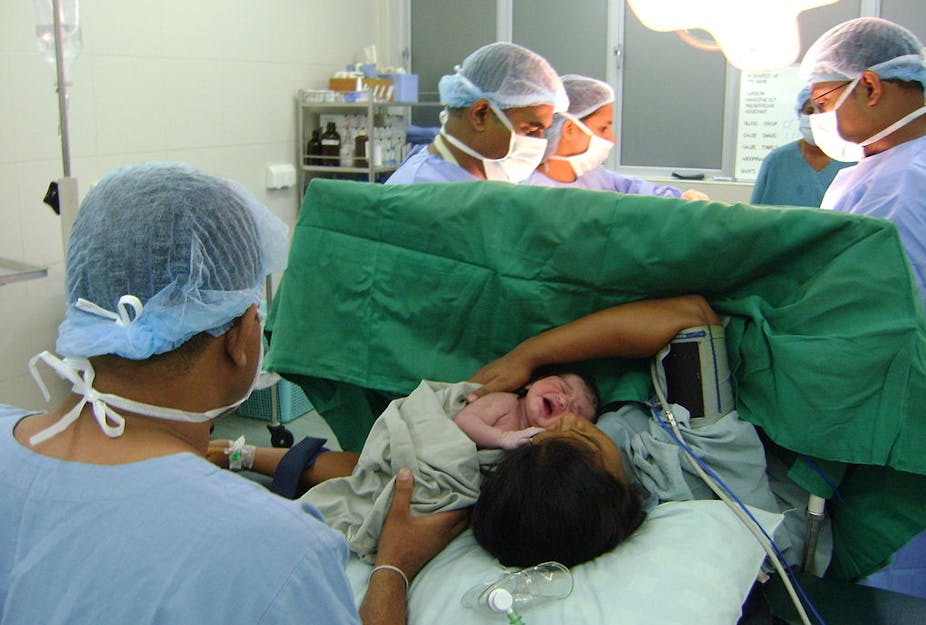Hospitals provide much-needed medical care and treatment for women who run into difficulty in childbirth. But many women and babies have medical intervention and treatment without good reason. We’ve become blind to the risks of some commonly used interventions and the importance of normal births for a good start in life.
Instead, we’re often led to believe that it is only safe to give birth in a hospital and surrounded by doctors.
Every year, less than half of pregnant women in the UK each year have a normal birth. And only 42% of births in England and Scotland happen without an induction, an epidural or spinal anaesthetic or assisted by forceps or ventouse (vacuum extraction). A quarter of babies born in the UK are now born by caesarean section.
Are these levels of intervention justified? There are wide variations in the number of interventions between different hospitals in England, which suggests that not all of these can always justified by clinical or demographic need.
Apparently innocuous interventions, such as clamping and cutting the umbilical immediately after birth, which have been carried out routinely may now be harmful. There is evidence that delaying clamping and cord cutting could prevent iron deficiency and improve the long-term development of the baby.
Medical interventions, especially caesareans, also carry significant risks. For the mother this includes haemorrhage, infection and thrombosis. For the baby it can lead to breathing difficulties, lung problems, prematurity caused by the operation being performed too early and difficulty with bonding and breast feeding.
Other problems may be life-threatening to the mother and baby in subsequent pregnancies. It was recently reported that a significant number of elective caesareans are now planned without a medical need and, more worrying still, performed before the 39 weeks recommended by the National Institute for Clinical Excellence](http://bit.ly/11oq9W1) despite evidence that a baby may not be ready for life outside the womb.
Birth at 37-38 weeks may mean worse long-term health and developmental outcomes, such as serious breathing problems, for these babies than for those carried full-term.
Why are interventions so high?
There are many explanations - and many more questions - about why we have such high levels of intervention.
Do professionals lean towards medical approaches because they don’t know or accept the evidence on the balance, benefits and risks of interventions? Is it a reflection of a society’s faith in technology and medical treatment; a loss of midwifery skills, confidence and autonomy; or is it the difficulty in gathering and interpreting evidence on complicated topics that are confounded by so many different factors?
It’s clear we need to reach a more sensible balance. One intervention often leads to another. A woman who has had one caesarean section is more likely to need a repeat. Induction of labour is likely to lead to caesarean birth and an epidural to the need for assisted birth. Continuous monitoring of the unborn baby’s heart in labour is more likely to lead to a caesarean birth in low-risk pregnancies, without evidence that this leads to better health for the baby.
Progressive policy but still room for choice
Maternity policy in the UK is among the world’s most progressive. For decades we’ve placed importance on the needs of individual women, and together with professionals, where they want to give birth and the kind of care they want and need.
But in reality it’s not women who are pushing increasing levels of intervention. Choosing to have a normal birth is not always easy, particularly when healthcare services steer more towards the medical. Reports of doctors and midwives bullying women into treatments they do not want for them and their babies is perhaps an indicator of the gap between policy and practice in some circumstances. Support for normal birth and avoidance of interventions is now seen by many as a human rights issue.
Evidence from international studies of midwife-led care without medical involvement - unless it is required - leads to an increase in the rate of normal birth, a reduction in major interventions and more reported satisfaction in care.
A recent major study compared midwife-led care in different settings such as home births or hospital birthing centres with obstetric unit care in low-risk pregnancies in England. Because women with uncomplicated pregnancies that plan their birth with midwife-led care have fewer interventions and care for the baby is generally safe, the results support a policy of offering healthy women a choice of where to give birth.
However, while women having their first babies as planned home births leads to fewer interventions, there is a small increase in the rate of adverse outcomes for the babies.
Yet care led by midwives is only available for a small proportion of women in the UK. To increase the number of normal births we must widen access to midwives and high quality information and give a genuine choice in the place of birth. We also need to ensure adequate personal support and use interventions only when necessary, while ensuring those women who need medical care get the medical attention they need.

